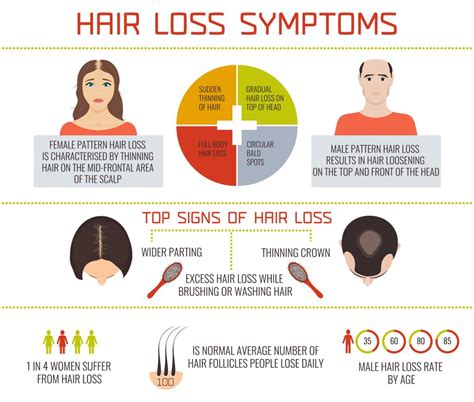Hair loss is a common problem that affects both men and women. It can be caused by a variety of factors including genetics, hormones, medications, and stress. While hair loss can occur anywhere on the scalp, it is most often seen on the top of the head.

There are a number of different types of hair loss, but the most common type is androgenetic alopecia (male-pattern baldness in men and female-pattern baldness in women). Androgenetic alopecia is caused by a combination of genetics and hormones. It typically begins in the late teens or early twenties, and it progresses gradually over time.
Other types of hair loss include:
- Telogen effluvium: This type of hair loss is caused by a temporary disruption of the hair growth cycle. Telogen effluvium can be caused by a variety of factors, including stress, illness, and certain medications.
- Alopecia areata: This type of hair loss is caused by an autoimmune disorder that attacks the hair follicles. Alopecia areata can cause hair loss in patches or it can lead to complete baldness.
- Trichotillomania: This type of hair loss is caused by a mental health disorder that leads to the compulsive pulling out of hair. Trichotillomania can cause hair loss in any area of the scalp, but it is most often seen on the top of the head.
Hair loss can be a distressing experience, but it is important to remember that you are not alone. There are a number of effective treatments for hair loss, and with early intervention, most people can achieve their desired results.
If you are concerned about hair loss on top of your head, there are a number of warning signs to look for:
- Thinning hair: This is the most common sign of hair loss. You may notice that your hair is becoming thinner or that you are losing more hair than usual when you brush or wash your hair.
- Receding hairline: This is a common sign of male-pattern baldness. If you have a receding hairline, you may notice that your forehead is becoming larger and that your hair is thinning at the temples.
- Bald spots: Bald spots are patches of hair loss that can occur anywhere on the scalp. Bald spots can be a sign of alopecia areata or trichotillomania.
- Itching or burning scalp: This can be a sign of an underlying medical condition, such as a fungal infection or psoriasis.
- Pain: Painful hair loss can be a sign of a serious medical condition, such as a tumor.
If you are experiencing any of these warning signs, it is important to see a doctor or dermatologist to determine the cause of your hair loss. Early diagnosis and treatment can help to prevent further hair loss and improve your chances of regaining your hair.
There are a number of different factors that can cause hair loss on top of the head, including:
- Genetics: Androgenetic alopecia is the most common cause of hair loss, and it is caused by a combination of genetics and hormones.
- Hormones: Hormones can play a role in hair loss, especially in women. Hair loss can occur during pregnancy, menopause, and after childbirth.
- Medications: Certain medications, such as chemotherapy drugs and blood thinners, can cause hair loss as a side effect.
- Stress: Stress can trigger hair loss, especially in people who are already predisposed to hair loss.
- Medical conditions: Certain medical conditions, such as thyroid disease and lupus, can cause hair loss.
- Lifestyle factors: Certain lifestyle factors, such as smoking and excessive alcohol consumption, can contribute to hair loss.
There are a number of effective treatments for hair loss on top of the head, including:
- Minoxidil: Minoxidil is a topical medication that is applied directly to the scalp. It is available in both over-the-counter and prescription strengths. Minoxidil works by stimulating hair growth and preventing further hair loss.
- Finasteride: Finasteride is an oral medication that is taken once a day. It is approved by the FDA for the treatment of male-pattern baldness. Finasteride works by blocking the production of dihydrotestosterone (DHT), a hormone that contributes to hair loss.
- Laser therapy: Laser therapy is a non-surgical treatment that involves the use of low-level lasers to stimulate hair growth. Laser therapy is available in both professional and home-use devices.
- Hair transplantation: Hair transplantation is a surgical procedure that involves transplanting hair follicles from a donor area to the balding area. Hair transplantation is a permanent solution to hair loss, but it can be expensive and time-consuming.
There are a number of things you can do to help prevent hair loss on top of your head, including:
- Maintain a healthy diet: A healthy diet that is rich in fruits, vegetables, and whole grains can help to promote healthy hair growth.
- Get regular exercise: Regular exercise can help to reduce stress and improve blood circulation, which can both contribute to healthy hair growth.
- Avoid smoking and excessive alcohol consumption: Smoking and excessive alcohol consumption can damage hair follicles and lead to hair loss.
- Use gentle hair care products: Avoid using harsh hair care products, such as those that contain sulfates or parabens. These products can damage hair follicles and lead to hair loss.
- Protect your hair from the sun: The sun’s ultraviolet (UV) rays can damage hair follicles and lead to hair loss. Be sure to wear a hat or scarf when you are outdoors.
Hair loss on top of the head can be a distressing experience, but it is important to remember that you are not alone. There are a number of effective treatments for hair loss, and with early intervention, most people can achieve their desired results. If you are concerned about hair loss on top of your head, be sure to see a doctor or dermatologist to determine the cause and get the best treatment for your needs.
